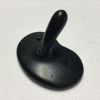PPH Butterfly: a novel device to treat postpartum haemorrhage through uterine compression
- PMID: 28250966
- PMCID: PMC5293860
- DOI: 10.1136/bmjinnov-2016-000144
PPH Butterfly: a novel device to treat postpartum haemorrhage through uterine compression
Abstract
Objective: Postpartum haemorrhage (PPH) is a significant cause of maternal morbidity and mortality. The most common cause is an inability of the uterus to contract adequately after childbirth. In bimanual compression (BMC), one hand is placed within the vagina and the other hand is on the abdominal wall to compress the uterus. It is effective, but very uncomfortable for the woman. We designed a device that could replicate BMC without inserting a hand vaginally, therefore being less invasive. It could also help in diagnosing the source of the bleeding.
Design: Mixed methods, combining an iterative design process with input from clinicians in simulations, and focus groups of clinicians and consumers.
Setting: Department of Women's and Children's Health and Department of Medical Physics and Clinical Engineering, University of Liverpool, UK.
Methods: A multidisciplinary team developed the design, using an obstetric manikin. Clinician and consumer groups also gave input on the concept and design. A healthcare product company and prototype manufacturer provided input into strategy, design and manufacture.
Results: The PPH Butterfly is a single piece, plastic medical device that replicates BMC. It is designed to be easy to use and low-cost and allows for smooth insertion and removal. It is acceptable to clinicians and consumers and performs well in tests.
Conclusions: This is the first device designed to replicate BMC while being less invasive. It could potentially be an effective form of PPH management, while also diagnosing the source of the bleeding. The device will now be tested in humans.
Keywords: Bimanual Compression; PPH Butterfly; Postpartum Haemorrhage; Treatment; Uterine Atony.
Conflict of interest statement
Competing interests: AW and JP are named as inventors of the device and would receive a proportion of any loyalties generated.
Figures














References
-
- Alkema L, Chou D, Hogan D, et al. . Global, regional, and national levels and trends in maternal mortality between 1990 and 2015, with scenario-based projections to 2030: a systematic analysis by the UN Maternal Mortality Estimation Inter-Agency Group. Lancet 2016;387:462–74. 10.1016/S0140-6736(15)00838-7 - DOI - PMC - PubMed
-
- Lori A. Hidden suffering: disabilities from pregnancy and childbirth in less developed countries. Washington: (DC: ): Population Reference Bureau, 2002. http://www.prb.org/pdf/HiddenSufferingEng.pdf
-
- WHO. Making pregnancy safer. Reducing the global burden: postpartum haemorrhage. Geneva, Switzerland: WHO, 2007.
-
- WHO. WHO recommendations for the prevention and treatment of postpartum haemorrhage. Geneva, Switzerland: WHO, 2007. - PubMed
Grants and funding
LinkOut - more resources
Full Text Sources
Other Literature Sources
